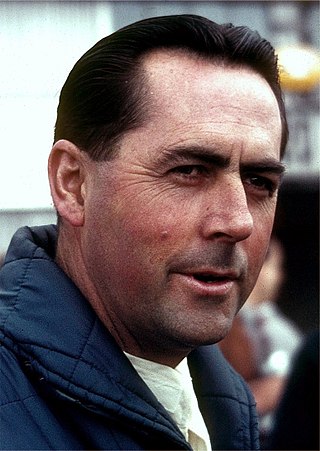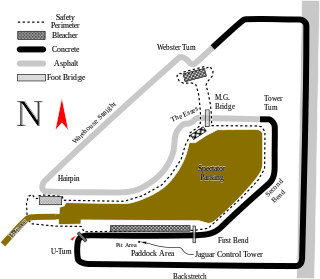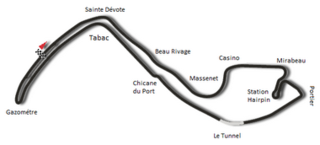The list below summarizes Brabham race cars built by Motor Racing Developments in the United Kingdom.
Note that many of the earlier models are badged as Repco Brabhams.
The list below summarizes Brabham race cars built by Motor Racing Developments in the United Kingdom.
Note that many of the earlier models are badged as Repco Brabhams.
Motor Racing Developments Ltd., commonly known as Brabham, was a British racing car manufacturer and Formula One racing team founded in 1960 by Australian driver Jack Brabham and British-Australian designer Ron Tauranac. The team won four FIA Formula One Drivers' and two Constructors' World Championships in its 30-year history, starting out with back-to-back wins of both in 1966 and 1967. Jack Brabham's 1966 Drivers' Championship remains the only such achievement using a car bearing the driver's own name.

Sir John Arthur Brabham was an Australian racing driver who was Formula One World Champion in 1959, 1960, and 1966. He was a founder of the Brabham racing team and race car constructor that bore his name.
Ian Gordon Murray, is a South African-British designer of Formula One racing cars for Brabham and McLaren and the McLaren F1 high-performance road car. Founder and CEO of Gordon Murray Design and Gordon Murray Automotive he has subsequently designed and built a number of sports cars and a variety of other automotive vehicles.

The 1959 United States Grand Prix was a Formula One motor race held on December 12, 1959, at Sebring International Raceway in Sebring, Florida. It was the last of 9 races in the 1959 World Championship of Drivers and the 8th and final in the 1959 International Cup for Formula One Manufacturers.It was the second United States Grand Prix, and the only occasion the race was held at the home of the 12 Hours of Sebring endurance sports car race, the Sebring International Raceway in Florida. The race was held over 42 laps of the 8.36-kilometre circuit for a total race distance of 351 kilometres.

The 1966 French Grand Prix was a Formula One motor race held at Reims on 3 July 1966. It was race 3 of 9 in both the 1966 World Championship of Drivers and the 1966 International Cup for Formula One Manufacturers. The race was the "60th Anniversary race" of Grand Prix racing, which had started with the GP of France in 1906. It was also the 16th and last time the French Grand Prix was held on variations of French highways near Reims, following a three-year absence from the region. The race was held over 48 laps of the 8.35-kilometre (5.19 mi) circuit for a race distance of 400.694 kilometres (248.980 mi).

The 1966 British Grand Prix was a Formula One motor race held at Brands Hatch on 16 July 1966. It was race 4 of 9 in both the 1966 World Championship of Drivers and the 1966 International Cup for Formula One Manufacturers. It was the 21st British Grand Prix and the second to be held at Brands Hatch. It was held over 80 laps of the four kilometre circuit for a race distance of 341 kilometres.

The 1970 Monaco Grand Prix was a Formula One motor race held at the Circuit de Monaco on 10 May 1970. It was race 3 of 13 in both the 1970 World Championship of Drivers and the 1970 International Cup for Formula One Manufacturers. Jochen Rindt scored the last victory for the famous Lotus 49.

The 1978 Swedish Grand Prix was a Formula One motor race held on 17 June 1978 at the Scandinavian Raceway. It was the eighth race of the 1978 World Championship of F1 Drivers and the 1978 International Cup for F1 Constructors, and the last Formula One Swedish Grand Prix to date.
The 1966 Formula One season was the 20th season of FIA Formula One motor racing. It featured the 1966 World Championship of Drivers and the 1966 International Cup for F1 Manufacturers which were contested concurrently over a nine-race series that commenced on 22 May and ended on 23 October. The season saw the "return to power" with the introduction of the '3 litre formula', doubling maximum engine capacity from 1.5 litres. Jack Brabham won the World Championship of Drivers and Brabham-Repco was awarded the International Cup for F1 Manufacturers.

The 1960 Formula One season was the 14th season of the FIA's Formula One motor racing. It featured the 11th FIA World Championship of Drivers, the third International Cup for F1 Manufacturers and numerous non-championship Formula One races. The World Championship commenced on 7 February and ended on 20 November after ten races.
The 1959 Formula One season was the 13th season of FIA Formula One motor racing. It featured the 1959 World Championship of Drivers and the 1959 International Cup for F1 Manufacturers, contested concurrently over a nine-race series which commenced on 10 May and ended on 12 December. The season also included several non-championship Formula One races.

David Philip Brabham is an Australian racing driver and one of the most successful and experienced specialists in sports car racing. He has won three international Sports Car series and is one of four Australians to have won the Le Mans 24 Hour sports car race, winning the event in 2009. Brabham won the American Le Mans Series in 2009 and 2010. He also competed in Formula One, racing for the Brabham and Simtek teams in 1990 and 1994, respectively. Brabham is the youngest son of three-time Formula One world champion Sir Jack Brabham, brother to Geoff Brabham and Gary Brabham. He is also brother-in-law to Mike Thackwell, father to Sam Brabham and uncle to Matthew Brabham.

Repco is an Australian automotive engineering/retailer company. Its name is an abbreviation of Replacement Parts Company and was for many years known for reconditioning engines and for specialised manufacturing, for which it gained a high reputation. It is now best known as a retailer of spare parts and motor accessories.
Gary Thomas Brabham is a former professional racing driver and a convicted child sex offender from Australia.

The Brabham BT46 is a Formula One racing car designed by Gordon Murray for the Brabham team, owned by Bernie Ecclestone, for the 1978 Formula One season. The car featured several radical design elements, one of which was the use of flat panel heat exchangers on the bodywork of the car to replace conventional water and oil radiators. It was removed before the car's race debut, never to be seen again. The cars, however, powered by a flat-12 Alfa Romeo engine, raced competitively with modified nose-mounted radiators for most of the year, driven by Niki Lauda and John Watson, winning one race in this form and scoring sufficient points for the team to finish third in the constructors championship.

Geoff Brabham is an Australian racing driver. Brabham spent the majority of his racing career in the United States.

The Brabham BT19 is a Formula One racing car designed by Ron Tauranac for the British Brabham team. The BT19 competed in the 1966 and 1967 Formula One World Championships and was used by Australian driver Jack Brabham to win his third World Championship in 1966. The BT19, which Brabham referred to as his "Old Nail", was the first car bearing its driver's name to win a World Championship race.

Matthew Chase Brabham is an Australian-American racing driver. He competes in the Trans-Am Series, driving the No. 20 Ford Mustang for Gym Weed. From 2015 to 2021, he was a regular in the Stadium Super Trucks, where he is a three-time series champion with titles in 2018, 2019 and 2021. He has also won championships in the Road to Indy ladder with the 2012 U.S. F2000 and 2013 Pro Mazda Championships.

The Brabham BT20 is a Formula One car used by the Brabham Formula One team in 1966 and 1967, as well as a number of privateers from 1967 to 1969. The BT20 was the direct successor to the Brabham BT19 which was driven to the World Constructors' title in 1966.

Brabham Automotive Ltd. was an Australian automaker launched by David Brabham and Australian investor group, Fusion Capital in May 2018. Brabham Automotive is based in Adelaide, South Australia, with representation also in the United Kingdom.